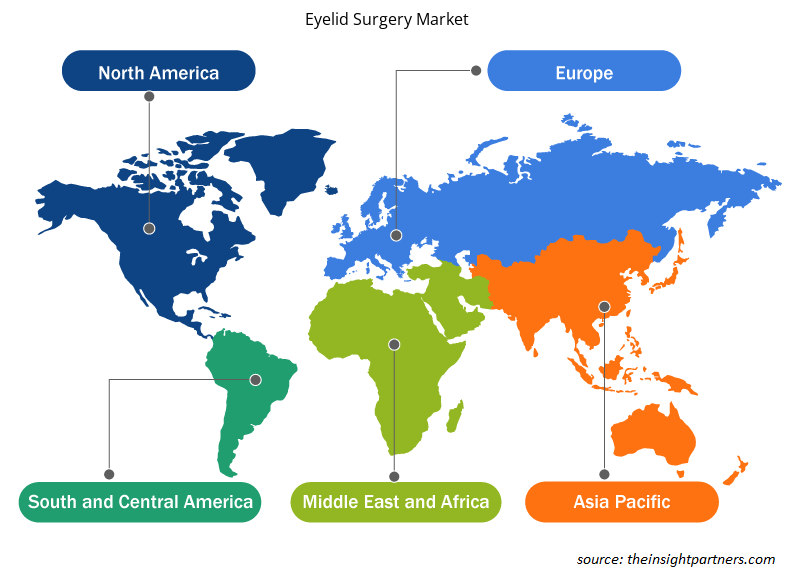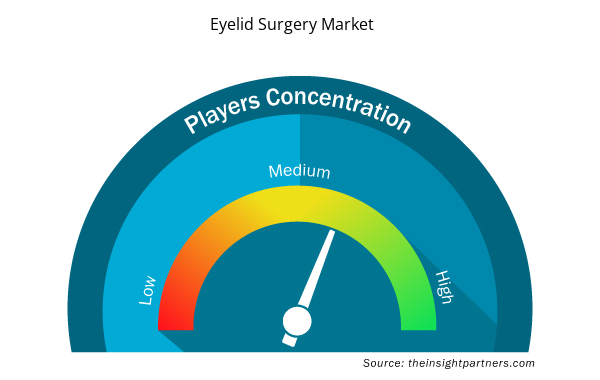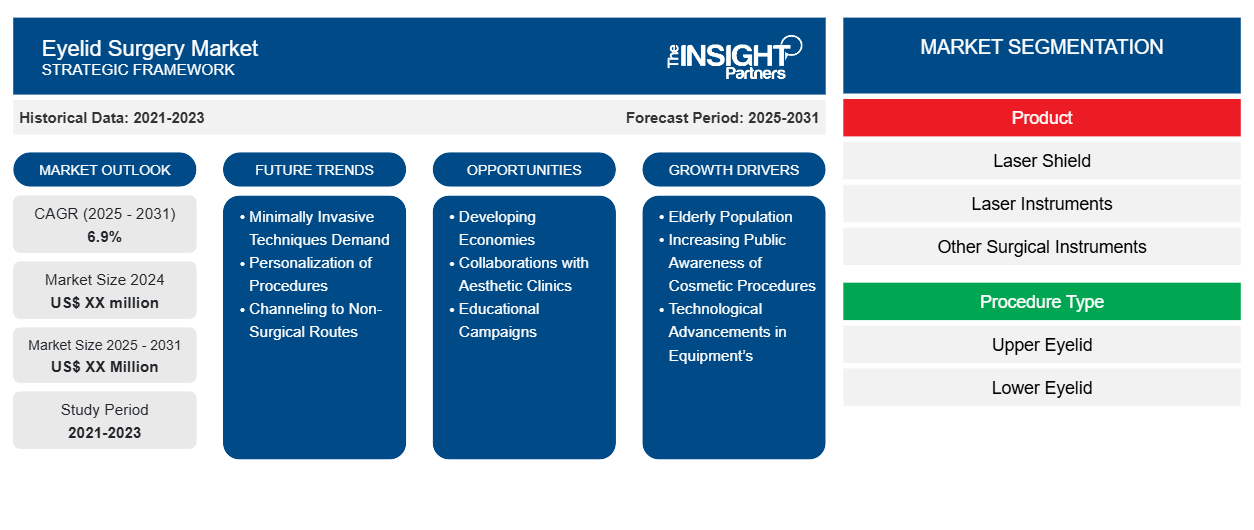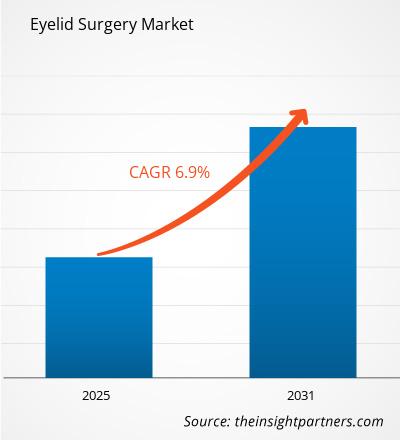Der Markt für Augenlidoperationen wird voraussichtlich von 2024 bis 2031 eine durchschnittliche jährliche Wachstumsrate (CAGR) von 6,9 % verzeichnen, wobei die Marktgröße von XX Millionen US-Dollar im Jahr 2024 auf XX Millionen US-Dollar im Jahr 2031 wachsen wird.
Der Bericht ist nach Produkt (Laserschutz, Laserinstrumente, andere chirurgische Instrumente) segmentiert. Der Bericht ist weiter nach Verfahrenstyp (oberes Augenlid, unteres Augenlid) segmentiert. Darüber hinaus ist er nach Endbenutzern (Krankenhäuser und Kliniken, Zentren für plastische Chirurgie) segmentiert. Die globale Analyse ist weiter auf regionaler Ebene und nach wichtigen Ländern aufgeschlüsselt. Der Bericht bietet den Wert in USD für die oben genannte Analyse und die Segmente.
Zweck des Berichts
Der Bericht „Markt für Augenlidoperationen“ von The Insight Partners soll die aktuelle Situation und das zukünftige Wachstum sowie die wichtigsten treibenden Faktoren, Herausforderungen und Chancen beschreiben. Dies wird verschiedenen Geschäftspartnern Einblicke geben, wie zum Beispiel:
- Technologieanbieter/-hersteller: Um die sich entwickelnde Marktdynamik zu verstehen und die potenziellen Wachstumschancen zu kennen, damit sie fundierte strategische Entscheidungen treffen können.
- Investoren: Durchführung einer umfassenden Trendanalyse hinsichtlich der Marktwachstumsrate, der finanziellen Marktprognosen und der Chancen entlang der Wertschöpfungskette.
- Regulierungsbehörden: Zur Regulierung von Richtlinien und Überwachungsaktivitäten auf dem Markt mit dem Ziel, Missbrauch zu minimieren, das Vertrauen der Anleger zu bewahren und die Integrität und Stabilität des Marktes aufrechtzuerhalten.
Augenlidchirurgie Marktsegmentierung
Produkt
- Laserschutz
- Laserinstrumente
- Andere chirurgische Instrumente
Prozedurtyp
- Oberes Augenlid
- Unteres Augenlid
Endbenutzer
- Krankenhäuser und Kliniken
- Zentren für plastische Chirurgie
Geographie
- Nordamerika
- Europa
- Asien-Pazifik
- Süd- und Mittelamerika
- Naher Osten und Afrika
Passen Sie diesen Bericht Ihren Anforderungen an
Sie erhalten kostenlos individuelle Anpassungen an jedem Bericht, einschließlich Teilen dieses Berichts oder einer Analyse auf Länderebene, eines Excel-Datenpakets sowie tolle Angebote und Rabatte für Start-ups und Universitäten.
- Holen Sie sich die wichtigsten Markttrends aus diesem Bericht.Dieses KOSTENLOSE Beispiel umfasst eine Datenanalyse von Markttrends bis hin zu Schätzungen und Prognosen.
Wachstumstreiber auf dem Markt für Augenlidoperationen
- Ältere Bevölkerung: Die wachsende, alternde Weltbevölkerung ist einer der Hauptfaktoren, die den Markt für Augenlidoperationen antreiben. Mit zunehmendem Alter beugt sich der menschliche Körper und bekommt Falten unter den Augen, was die Nachfrage nach Verfahren wie Blepharoplastiken erhöht, um das Aussehen und die Sehkraft einer Person zu verbessern.
- Steigendes öffentliches Bewusstsein für kosmetische Eingriffe: Auch das allgemeine Bewusstsein und die Akzeptanz der Bevölkerung für kosmetische Chirurgie haben im Laufe der Jahre zugenommen. Tatsächlich verbessert die Aufmerksamkeit durch verschiedene Medienformen, Werbung in sozialen Netzwerken und die Unterstützung durch Prominente weiterhin die Akzeptanz von Augenlidoperationen bei Bürgern, die solche Eingriffe wünschen.
- Technologische Fortschritte bei der Ausrüstung: Augenlidoperationen werden durch die Weiterentwicklung der Operationstechniken und technologischen Mittel, wie weniger invasive Verfahren und bessere Anästhesiemöglichkeiten, einfacher und sicherer. Letztendlich kommen diese Fortschritte den Patienten zugute und verkürzen gleichzeitig die Erholungszeit nach der Operation, was den Eingriff für potenzielle Patienten noch attraktiver macht.
Markttrends für Augenlidoperationen
- Nachfrage nach minimalinvasiven Techniken: Der Trend zu minimalinvasiven chirurgischen Optionen wird sich fortsetzen. Techniken, die kleinere Einschnitte und eine schnellere Genesung erfordern, werden immer beliebter, da sie den Patienten effektive Ergebnisse mit minimalen Problemen und Ausfallzeiten bieten können.
- Personalisierung von Eingriffen: Bei jedem Patienten werden kosmetische Eingriffe mehr denn je auf die individuellen Bedürfnisse und Wünsche des Patienten zugeschnitten. Chirurgen verwenden zunehmend fortschrittliche Bildgebungstechnologien, um Pläne für individuelle Operationen zu erstellen, da dies die Patientenzufriedenheit und die Ergebnisse erhöht.
- Umstellung auf nicht-chirurgische Behandlungsmethoden: Die zunehmende Verbreitung nicht-chirurgischer Alternativen wie injizierbare Medikamente und Laserbehandlungen verändert den Markt für Augenlidoperationen. Der Patient kann sich zunächst für diese weniger invasiven Optionen entscheiden und sich in zunehmendem Maße auch für andere chirurgische Optionen entscheiden.
Marktchancen für Augenlidoperationen
- Entwicklungsländer: Eine weitere Kategorie mit enormem Wachstumspotenzial sind die Schwellenmärkte. Dort steigen die verfügbaren Einkommen und der Zugang zu kosmetischen Eingriffen verbessert sich. Das Bewusstsein für ästhetische Chirurgie wächst in diesen Regionen; daher würde die Nachfrage nach Augenlidoperationen boomen.
- Kooperationen mit Schönheitskliniken: Praxismöglichkeiten können sich auch aus Kooperationen zwischen plastischen Chirurgen und Schönheitskliniken ergeben. Anbieter, die umfassende chirurgische und nichtchirurgische Pakete anbieten, können ein breiteres Klientel für ihre Praxis gewinnen.
- Aufklärungskampagnen: Eine erhöhte Anzahl von Aufklärungsprogrammen, die potenzielle Patienten auf die Vorteile und Sicherheit von Augenlidoperationen aufmerksam machen, würde das Marktwachstum beschleunigen. Die meisten Gesundheitsdienstleister würden die Akzeptanz dieser Behandlungen durch die Verbreitung von Fakten gegen damit verbundene gängige Mythen und Missverständnisse steigern.
Regionale Einblicke in den Markt für Augenlidoperationen
Die regionalen Trends und Faktoren, die den Markt für Augenlidoperationen im Prognosezeitraum beeinflussen, wurden von den Analysten von Insight Partners ausführlich erläutert. In diesem Abschnitt werden auch die Marktsegmente und die Geografie der Augenlidoperationen in Nordamerika, Europa, im asiatisch-pazifischen Raum, im Nahen Osten und Afrika sowie in Süd- und Mittelamerika erörtert.

- Erhalten Sie regionale Daten zum Markt für Augenlidoperationen
Umfang des Marktberichts zur Augenlidchirurgie
| Berichtsattribut | Details |
|---|---|
| Marktgröße im Jahr 2024 | XX Millionen US-Dollar |
| Marktgröße bis 2031 | XX Millionen US-Dollar |
| Globale CAGR (2024 - 2031) | 6,9 % |
| Historische Daten | 2021-2023 |
| Prognosezeitraum | 2025–2031 |
| Abgedeckte Segmente | Nach Produkt
|
| Abgedeckte Regionen und Länder | Nordamerika
|
| Marktführer und wichtige Unternehmensprofile |
|
Dichte der Marktteilnehmer für Augenlidoperationen: Die Auswirkungen auf die Geschäftsdynamik verstehen
Der Markt für Augenlidoperationen wächst rasant, angetrieben durch die steigende Nachfrage der Endnutzer aufgrund von Faktoren wie sich entwickelnden Verbraucherpräferenzen, technologischen Fortschritten und einem größeren Bewusstsein für die Vorteile des Produkts. Mit steigender Nachfrage erweitern Unternehmen ihr Angebot, entwickeln Innovationen, um die Bedürfnisse der Verbraucher zu erfüllen, und nutzen neue Trends, was das Marktwachstum weiter ankurbelt.
Die Marktteilnehmerdichte bezieht sich auf die Verteilung der Firmen oder Unternehmen, die in einem bestimmten Markt oder einer bestimmten Branche tätig sind. Sie gibt an, wie viele Wettbewerber (Marktteilnehmer) in einem bestimmten Marktraum im Verhältnis zu seiner Größe oder seinem gesamten Marktwert präsent sind.
Die wichtigsten auf dem Markt für Augenlidoperationen tätigen Unternehmen sind:
- Lumenis
- IOPTIMA LTD.
- Oculo-Plastik, Inc.
- Chirurgische Instrumente von Sklar.
- BMT Medizintechnik GmbH
Haftungsausschluss : Die oben aufgeführten Unternehmen sind nicht in einer bestimmten Reihenfolge aufgeführt.

- Überblick über die wichtigsten Akteure auf dem Markt für Augenlidoperationen
Wichtige Verkaufsargumente
- Umfassende Abdeckung: Der Bericht deckt die Analyse von Produkten, Dienstleistungen, Typen und Endbenutzern des Marktes für Augenlidchirurgie umfassend ab und bietet einen ganzheitlichen Überblick.
- Expertenanalyse: Der Bericht basiert auf dem umfassenden Verständnis von Branchenexperten und Analysten.
- Aktuelle Informationen: Der Bericht stellt durch die Abdeckung aktueller Informationen und Datentrends Geschäftsrelevanz sicher.
- Anpassungsoptionen: Dieser Bericht kann angepasst werden, um spezifische Kundenanforderungen zu erfüllen und die Geschäftsstrategien optimal anzupassen.
Der Forschungsbericht zum Markt für Augenlidoperationen kann daher dabei helfen, die Branchensituation und Wachstumsaussichten zu entschlüsseln und zu verstehen. Obwohl es einige berechtigte Bedenken geben kann, überwiegen die allgemeinen Vorteile dieses Berichts tendenziell die Nachteile.
- Historische Analyse (2 Jahre), Basisjahr, Prognose (7 Jahre) mit CAGR
- PEST- und SWOT-Analyse
- Marktgröße Wert/Volumen – Global, Regional, Land
- Branche und Wettbewerbsumfeld
- Excel-Datensatz



Report Coverage
Revenue forecast, Company Analysis, Industry landscape, Growth factors, and Trends

Segment Covered
This text is related
to segments covered.

Regional Scope
North America, Europe, Asia Pacific, Middle East & Africa, South & Central America

Country Scope
This text is related
to country scope.
Häufig gestellte Fragen
The rising elderly population and increasing public awareness of cosmetic procedures are the major factors boosting the eyelid surgery market growth
The North America region accounts for highest revenue share in eyelid surgery market.
Asia Pacific is estimated to grow at the highest CAGR over the forecast year (2023 - 2031).
The market is expected to grow at a CAGR of 6.9%
The final report will duly include market size and projection estimates for all the segments from 2021 to 2031, along with a revenue share and compound annual growth rate (%) for the regional/country-wise market wherein 2021-2022 are the historic years, 2023 is considered to be the base year, and the forecast will be provided till 2031, along with CAGR (%).
Lumenis, Oculo-Plastik, Inc., Sklar Surgical Instruments, and BMT Medizintechnik GmbH are the major companies operating in the eyelid surgery market
Trends and growth analysis reports related to Life Sciences : READ MORE..
1. Lumenis2. IOPTIMA LTD.3. Oculo-Plastik, Inc.4. Sklar Surgical Instruments.5. BMT Medizintechnik GmbH6. Romo Plastic Surgery.(Karl Storz)7. Stanford Health Care.8. Mayo Foundation for Medical Education and Research9. Cadogan Clinic10. Belo Medical Group
The Insight Partners performs research in 4 major stages: Data Collection & Secondary Research, Primary Research, Data Analysis and Data Triangulation & Final Review.
- Data Collection and Secondary Research:
As a market research and consulting firm operating from a decade, we have published and advised several client across the globe. First step for any study will start with an assessment of currently available data and insights from existing reports. Further, historical and current market information is collected from Investor Presentations, Annual Reports, SEC Filings, etc., and other information related to company’s performance and market positioning are gathered from Paid Databases (Factiva, Hoovers, and Reuters) and various other publications available in public domain.
Several associations trade associates, technical forums, institutes, societies and organization are accessed to gain technical as well as market related insights through their publications such as research papers, blogs and press releases related to the studies are referred to get cues about the market. Further, white papers, journals, magazines, and other news articles published in last 3 years are scrutinized and analyzed to understand the current market trends.
- Primary Research:
The primarily interview analysis comprise of data obtained from industry participants interview and answers to survey questions gathered by in-house primary team.
For primary research, interviews are conducted with industry experts/CEOs/Marketing Managers/VPs/Subject Matter Experts from both demand and supply side to get a 360-degree view of the market. The primary team conducts several interviews based on the complexity of the markets to understand the various market trends and dynamics which makes research more credible and precise.
A typical research interview fulfils the following functions:
- Provides first-hand information on the market size, market trends, growth trends, competitive landscape, and outlook
- Validates and strengthens in-house secondary research findings
- Develops the analysis team’s expertise and market understanding
Primary research involves email interactions and telephone interviews for each market, category, segment, and sub-segment across geographies. The participants who typically take part in such a process include, but are not limited to:
- Industry participants: VPs, business development managers, market intelligence managers and national sales managers
- Outside experts: Valuation experts, research analysts and key opinion leaders specializing in the electronics and semiconductor industry.
Below is the breakup of our primary respondents by company, designation, and region:

Once we receive the confirmation from primary research sources or primary respondents, we finalize the base year market estimation and forecast the data as per the macroeconomic and microeconomic factors assessed during data collection.
- Data Analysis:
Once data is validated through both secondary as well as primary respondents, we finalize the market estimations by hypothesis formulation and factor analysis at regional and country level.
- Macro-Economic Factor Analysis:
We analyse macroeconomic indicators such the gross domestic product (GDP), increase in the demand for goods and services across industries, technological advancement, regional economic growth, governmental policies, the influence of COVID-19, PEST analysis, and other aspects. This analysis aids in setting benchmarks for various nations/regions and approximating market splits. Additionally, the general trend of the aforementioned components aid in determining the market's development possibilities.
- Country Level Data:
Various factors that are especially aligned to the country are taken into account to determine the market size for a certain area and country, including the presence of vendors, such as headquarters and offices, the country's GDP, demand patterns, and industry growth. To comprehend the market dynamics for the nation, a number of growth variables, inhibitors, application areas, and current market trends are researched. The aforementioned elements aid in determining the country's overall market's growth potential.
- Company Profile:
The “Table of Contents” is formulated by listing and analyzing more than 25 - 30 companies operating in the market ecosystem across geographies. However, we profile only 10 companies as a standard practice in our syndicate reports. These 10 companies comprise leading, emerging, and regional players. Nonetheless, our analysis is not restricted to the 10 listed companies, we also analyze other companies present in the market to develop a holistic view and understand the prevailing trends. The “Company Profiles” section in the report covers key facts, business description, products & services, financial information, SWOT analysis, and key developments. The financial information presented is extracted from the annual reports and official documents of the publicly listed companies. Upon collecting the information for the sections of respective companies, we verify them via various primary sources and then compile the data in respective company profiles. The company level information helps us in deriving the base number as well as in forecasting the market size.
- Developing Base Number:
Aggregation of sales statistics (2020-2022) and macro-economic factor, and other secondary and primary research insights are utilized to arrive at base number and related market shares for 2022. The data gaps are identified in this step and relevant market data is analyzed, collected from paid primary interviews or databases. On finalizing the base year market size, forecasts are developed on the basis of macro-economic, industry and market growth factors and company level analysis.
- Data Triangulation and Final Review:
The market findings and base year market size calculations are validated from supply as well as demand side. Demand side validations are based on macro-economic factor analysis and benchmarks for respective regions and countries. In case of supply side validations, revenues of major companies are estimated (in case not available) based on industry benchmark, approximate number of employees, product portfolio, and primary interviews revenues are gathered. Further revenue from target product/service segment is assessed to avoid overshooting of market statistics. In case of heavy deviations between supply and demand side values, all thes steps are repeated to achieve synchronization.
We follow an iterative model, wherein we share our research findings with Subject Matter Experts (SME’s) and Key Opinion Leaders (KOLs) until consensus view of the market is not formulated – this model negates any drastic deviation in the opinions of experts. Only validated and universally acceptable research findings are quoted in our reports.
We have important check points that we use to validate our research findings – which we call – data triangulation, where we validate the information, we generate from secondary sources with primary interviews and then we re-validate with our internal data bases and Subject matter experts. This comprehensive model enables us to deliver high quality, reliable data in shortest possible time.


 Holen Sie sich ein kostenloses Muster für diesen Bericht
Holen Sie sich ein kostenloses Muster für diesen Bericht